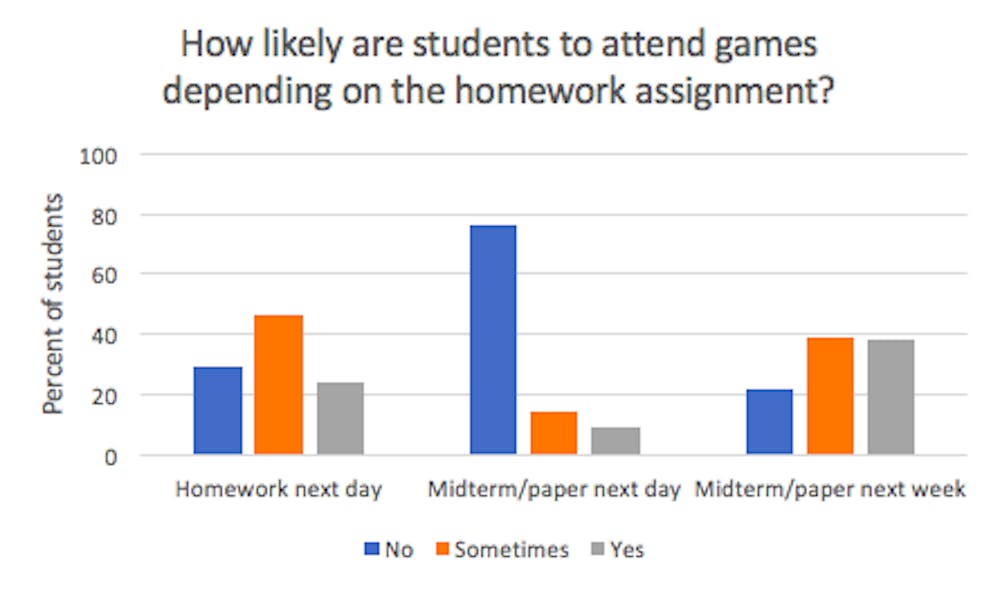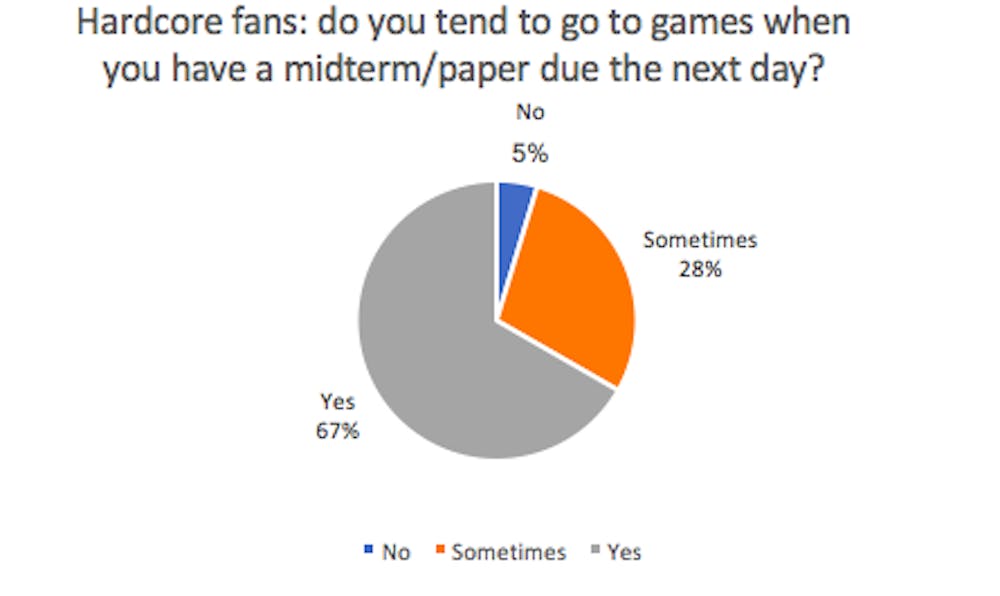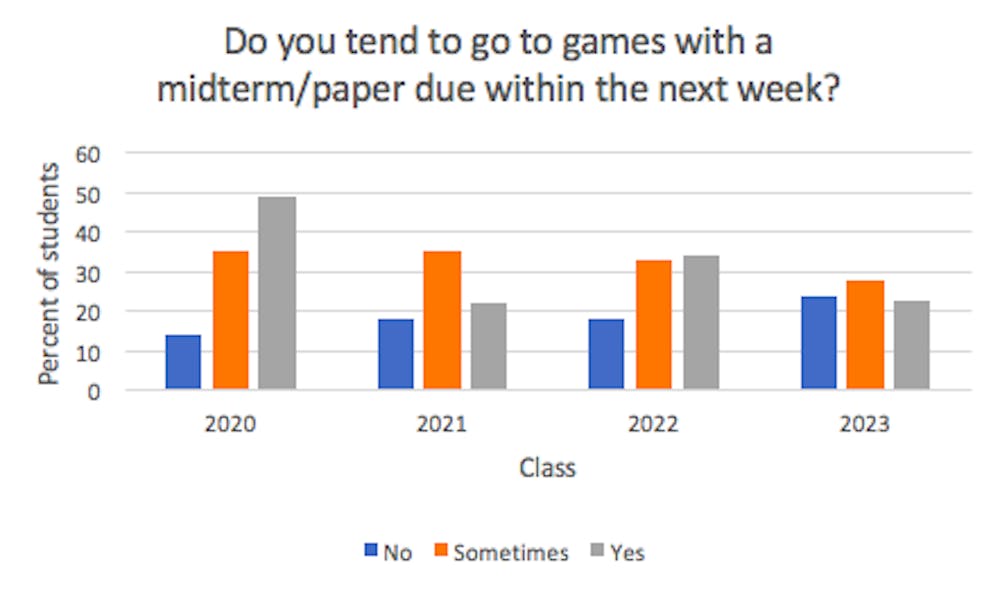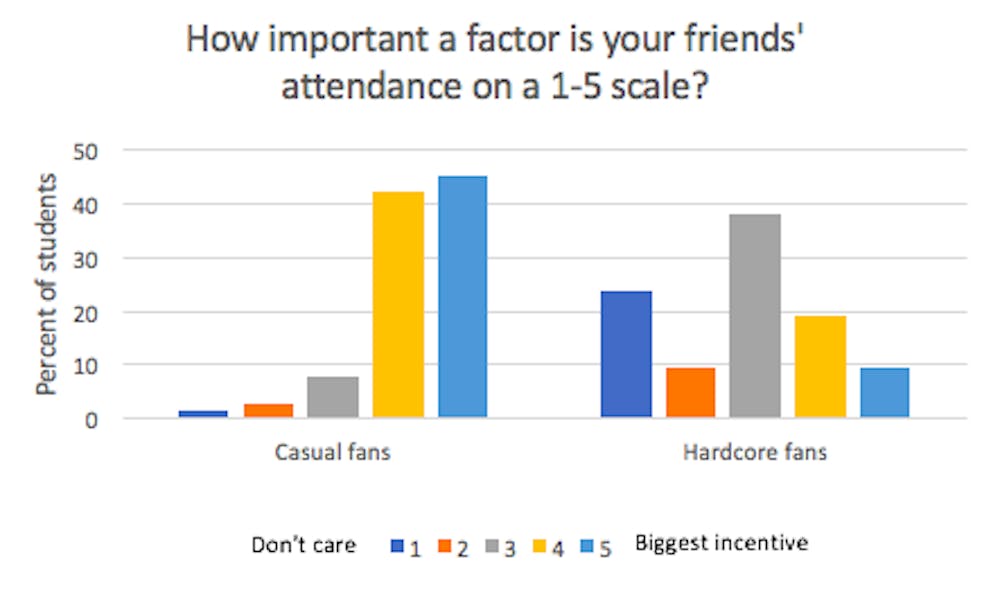Editor's note: This is part of a series about the Duke men’s basketball walk-up line experience based on a survey conducted by The Chronicle. You can learn more about the methodology and limitations of the survey here, student opinions on the in-game experience here and thoughts on the pregame process here.
Obviously, there are many reasons for declining student attendance at basketball games. One of the most prevalent factors we found from our study, however, was homework.
Duke is incredibly unique in that it is one of very few elite academic institutions to also boast a top-tier men’s basketball program. While that balance is exactly what attracts many top students to Durham, it can also have its drawbacks.
From projects and problem sets to midterms and essays, students at Duke seem to have a never-ending list of tasks to tackle at any given moment. So, how do they decide between attending a game and keeping up with all of their other commitments? How likely are students to spend a couple hours inside the mythical walls of Cameron Indoor Stadium when yet another assignment is looming just around the corner?
Let’s dive into the data.
Very few students go to games with a midterm/paper due the next day, but a select group of hardcore fans typically do
First, let’s compare the overall data with regards to whether students said they tend to go to games if they have homework due the next day, a midterm/paper due the next day or a midterm/paper due within the next week.

As you can see, many students are unsure about attending games if they have homework due the next day or a midterm/paper due within the next week. But when it comes to having a midterm or paper due the next day, the vast majority—77 percent—say they tend to not go.
Given that studying for a midterm or finishing up an essay typically takes up the majority of one’s night, it’s understandable that students would rather not spend two-plus hours of that night inside Cameron Indoor Stadium. But for a select group of students, whether or not they have a midterm or essay due the next day doesn’t seem to matter.

In order to split up our respondents into levels of fandom, we pivoted between various amounts of home games attended this season. Above are the responses of the subgroup that had attended 10+ games in Cameron this season at the time they took the survey (the most "hardcore" group), answering the question of whether or not they tend to go to games with a midterm or paper due the next day.
While this subgroup only contains 21 of the 333 total responses to this question, their responses differ greatly from the other groups. Compared to the 77 percent of overall students who said they tend not to attend games with a midterm or paper due the next day, only one single member (5%) of this hardcore fan group gave that same answer. Meanwhile, six respondents (28%) said they sometimes go, while an astounding 14 (67%) said they tend to go to games.
Yes, you read that right: within this hardcore group, students are much more likely than not to attend a two-plus-hour basketball game the night before a midterm or the due date of an essay. Some people really are “Cameron Crazies.”
Seniors and Trinity students are more likely to attend games with a midterm/paper due within the next week
With regards to homework, there is one other key takeaway from the data: the differences in tendency to attend games when a midterm/paper is due within the next week.
While differences between Trinity and Pratt students and between classes are virtually nonexistent when it comes to homework due the next day or a midterm/paper due the next day, there are some pretty drastic shifts in behavior when it comes to longer-term assignments.

Only 31 percent of first-years, 40 percent of sophomores and 29 percent of juniors say they tend to go to games when they have a midterm or paper due within the next week. But when it comes to seniors, that number jumps to 50 percent.
The same differences can be seen within Trinity and Pratt students as well. While 40 percent of Trinity students say they tend to go to games with a midterm or paper due within the week, that number drops to 31 percent for their engineering counterparts.
Do seniors finally realize that studying for that midterm a week in advance isn’t worth missing a game in Cameron? Do more demanding long-term projects in Pratt prevent its students from attending games? Those kinds of questions are up for interpretation, but our data suggests something along those lines.
Upperclassmen care a lot about whether their friends are going, first-years not as much
In addition to homework, there’s one other major factor of student attendance that we uncovered in our survey: friends.
When deciding between going to a game or not, students care a lot about whether their friends will be joining them. In response to the question of how big of an influence the attendance of your friends has on your own attendance to a game, a whopping 77 percent of the overall respondents rated it a four or five on a five-point scale.
But not all students see it as their biggest motivator of attendance.
Between seniors, juniors and sophomores, the most popular response was a five on a five-point scale. But for freshmen, far more respondents answered with four rather than five.

While the proportion of four and five responses combined were similar across all classes, there was something discouraging first-years from selecting that highest number. Perhaps the wording of the survey was a factor—the question indicated that a one meant you “didn’t care” and a five was one’s “biggest incentive.” Furthermore, since many first-years have yet to develop the close friendships that upperclassmen have had the time to create and maintain, they may be more likely to go to a game regardless of what their immediate peers are doing.
Casual fans need their friends
My last point once again pertains to the differences of opinion between different levels of fans. In this case, casual fans are seen as those who had attended 1-3 home games this season at the time they took the survey, while hardcore fans were again the 10+ games category.

While a combined 88 percent of so-called casual fans select either a four or five on a five-point scale with regards to the influence of their friends’ attendance, the responses from the hardcore fans are far more spread out—the leading answer was three at 38 percent, with the numbers one and four not far behind at 24 and 19 percent, respectively.
Get The Chronicle straight to your inbox
Signup for our weekly newsletter. Cancel at any time.
